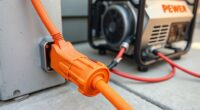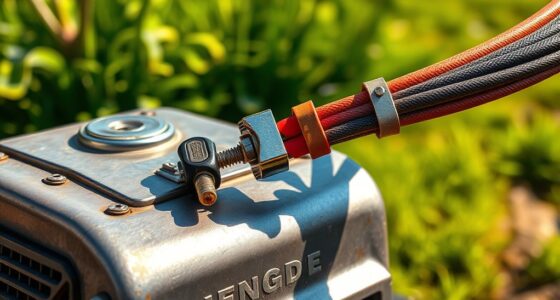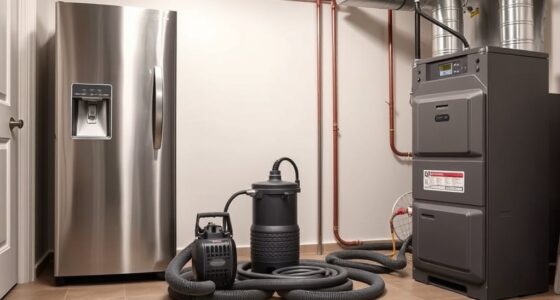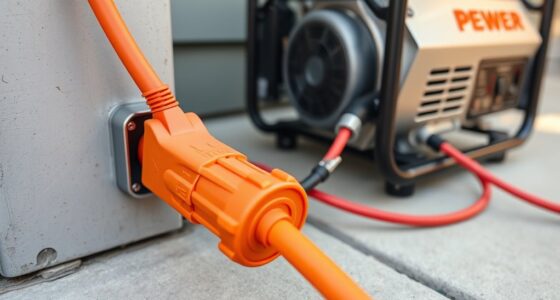Choosing between manual and automatic transfer switches depends on your home’s needs. Manual switches are simple, cost-effective, and give you control, but require your action during outages, which can cause delays. Automatic switches detect power loss instantly and switch seamlessly, offering greater convenience and safety without intervention. Consider your budget, safety priorities, and maintenance comfort. Continue to explore the details to find the best fit for your home’s power security.
Key Takeaways
- Manual switches are cost-effective, simple to install, and require user operation during outages.
- Automatic switches detect power failures instantly and switch sources seamlessly without user intervention.
- Manual systems need regular inspections and safety checks; automatic systems require calibration and safety testing.
- Automatic transfer switches offer greater convenience, safety, and quick power restoration, ideal for critical home systems.
- Choose manual if budget is limited and you prefer control; opt for automatic for reliability, convenience, and safety.
How Manual Transfer Switches Operate

Have you ever wondered how manual transfer switches work during a power outage? When the power goes out, you manually operate the switch by toggling it from the utility source to your backup generator. This process is straightforward and relies on switch toggling to guarantee your home’s electrical system switches safely and effectively. You physically move the switch lever or handle to connect your home’s circuits to the generator, preventing back-feeding into the grid. Manual operation requires your intervention, giving you control over when to switch sources. It’s a reliable system that doesn’t depend on power or complex electronics. Instead, it relies on simple, mechanical switch toggling, making it easy for you to manage during an outage. Additionally, understanding the different types of transfer switches can help you choose the best option for your home. Knowing the maintenance requirements of manual switches can also ensure long-term reliability and safety. Regular inspections and testing are recommended to keep the system in optimal condition, especially considering the AI-driven safety monitoring advancements in modern systems. Incorporating simple mechanical components can further enhance the durability and ease of use of manual transfer switches.
How Automatic Transfer Switches Function

Automatic transfer switches detect power outages instantly, so you don’t have to. They switch to backup power smoothly, minimizing interruptions. This seamless shift keeps your systems running without delay or fuss. Additionally, choosing the right switch involves considering durable materials, ensuring longevity and reliable performance during emergencies. Proper maintenance and quality components further enhance their performance and reliability, providing peace of mind during unexpected outages. Incorporating advanced safety features can also prevent potential electrical hazards and enhance overall system security. Being aware of regulatory compliance challenges can help in selecting systems that meet safety standards and legal requirements. Moreover, integrating predictive analytics into maintenance routines can help anticipate potential failures before they occur, ensuring continuous operation.
Automatic Power Detection
When the main power supply fails or drops below a certain voltage level, automatic transfer switches actively monitor the electrical system to detect these changes. They constantly check the incoming power, guaranteeing your home stays powered without interruption. This detection process is vital for compatibility with various energy sources, including renewable energy systems and generators. If your system integrates solar panels or wind turbines, the switch recognizes these sources as backup power options, enabling quick switching when needed. The switch’s sensors assess voltage stability and power quality, guaranteeing a seamless transition to backup power without manual intervention. Proper maintenance and testing of the switch ensure ongoing reliability and safety. Regular inspection and calibration help maintain optimal performance and safety standards. An understanding of net worth of influential individuals can also provide insights into the importance of reliable systems in various contexts. Understanding how these switches work is essential for ensuring your home’s energy reliability and safety. This automatic detection enhances reliability, keeps your devices safe, and guarantees your home remains energized during outages or fluctuations. Additionally, advancements in aura technology have improved the precision and responsiveness of detection systems, making automatic transfer switches more efficient and dependable.
Seamless Transition Process
Once the system detects a power failure or fluctuation, the transfer switch springs into action, swiftly switching your power source without causing disruptions. Automatic transfer switches coordinate seamlessly with your generator, guaranteeing proper generator sizing for reliable backup power. They monitor incoming power continuously and activate within seconds, providing a smooth transition that minimizes downtime. Proper installation requirements are vital; the switch must be correctly wired and compatible with your generator to guarantee safe operation. When configured correctly, the switch automatically disconnects your home from the utility and connects it to the generator, then reverses the process when power is restored. This seamless transition process helps protect your appliances and maintains a steady power supply, giving you peace of mind during outages. Additionally, understanding the navigation and mapping features of modern automatic transfer switches can help optimize their performance and ensure reliable operation. As technology advances, integration with AI-powered systems can further enhance the efficiency and responsiveness of your transfer switch. Incorporating remote monitoring capabilities allows for real-time diagnostics and maintenance alerts, ensuring your system remains operational at all times. Moreover, awareness of power quality considerations can help prevent damage to sensitive electronics during transfer processes. Recognizing the importance of arcade machines and their technology could inspire innovative improvements in transfer switch design to better support modern electronic loads.
Benefits of Manual Transfer Switches

Manual transfer switches offer several advantages that make them a popular choice for many homeowners and small businesses. One key benefit is manual safety, giving you direct control over power sources during outages, reducing accidental energizing of circuits. This control helps prevent electrical hazards and guarantees you can safely switch between utility power and backup generators. Additionally, manual transfer switches are generally simpler to install, with fewer components involved, which can lower installation costs and complexity. They also require less maintenance over time. Because you’re responsible for switching power sources, you need to follow proper installation considerations to ensure safe operation. Proper training and awareness are essential to safely operate manual transfer switches and prevent accidents. Proper exposure to safety protocols can further enhance safe operation and user confidence. Understanding electrical system fundamentals can help users better manage power transfer processes. Moreover, manual switches can be a more cost-effective solution for smaller electrical systems, making them accessible for various applications. Recognizing the importance of safety procedures can significantly reduce risks associated with manual operation. Overall, manual transfer switches provide a reliable, cost-effective solution that emphasizes safety and user control during power disruptions.
Advantages of Automatic Transfer Switches

Automatic transfer switches offer the significant advantage of seamless power transfer, guaranteeing your home or business stays powered without manual intervention. When the main power fails, the switch automatically detects the outage and switches to your generator, providing uninterrupted power. This process minimizes downtime and enhances safety by eliminating the need for manual operation. Many automatic switches are compatible with various generators, making them versatile options for different setups. Additionally, they support battery backup systems, allowing for quick startup even if the generator takes a moment to engage. This reliability ensures your essential appliances and systems stay online, protecting your property and productivity. Overall, automatic transfer switches streamline power management and give you peace of mind during outages. Furthermore, they help prevent potential issues caused by improper maintenance or delayed manual response, ensuring continuous power supply.]
Factors to Consider When Choosing Between Them

When choosing between manual and automatic transfer switches, you need to think about your budget and how much you’re willing to spend. Ease of use and ongoing maintenance also play a big role in making the right choice. Consider these factors carefully to find the option that best fits your needs. Additionally, evaluate the ease of maintenance requirements, such as filter replacements or system checks, to ensure long-term reliability.
Cost and Budget Constraints
Budget constraints play a essential role in determining which transfer method suits your needs best. Manual transfer systems generally have lower upfront installation costs, making them appealing if you’re working with a tight budget. However, consider the long-term expenses; manual systems may require more frequent maintenance or repairs, which can add up over time. Automatic transfer switches tend to have higher initial costs but can save money in the long run through reduced maintenance and quicker, more reliable operation. If your budget is limited, a manual system might be more feasible initially, but if you prioritize convenience and lower ongoing expenses, investing in an automatic transfer switch could be more cost-effective over time. Always weigh upfront costs against potential long-term savings before making your decision.
Ease of Use and Maintenance
Choosing between manual and automatic transfer systems often hinges on how easy they are to operate and maintain. For emergency preparedness, you want a system that’s reliable and simple to use during stressful situations. Manual transfer switches are straightforward, requiring minimal maintenance, but they demand your active involvement during outages. Automatic systems, while more complex to install, offer seamless operation, automatically switching power without your intervention. However, their installation complexity can mean higher upfront costs and more ongoing maintenance. If you prefer a low-maintenance setup that you control, manual transfer may suit you best. Conversely, if ease of use during emergencies is your priority, investing in an automatic transfer switch enhances safety and convenience, despite the added installation effort.
Making the Right Choice for Your Home

Selecting between manual and automatic transfer switches depends on your home’s specific needs and your comfort level with system operation. If home safety is your top priority, an automatic switch minimizes the risk of power loss during outages by quickly switching power sources, ensuring continuous protection. For energy efficiency, automatic systems reduce downtime and prevent unnecessary energy consumption. However, if you prefer a more hands-on approach and want to keep costs lower, a manual switch might suit you better. Consider your comfort with electrical systems and how much control you want over the transfer process. Ultimately, choosing the right system involves balancing safety, efficiency, and your ability to manage the device. Assess your home’s power needs and your personal preferences to make an informed decision.
Frequently Asked Questions
What Is the Typical Cost Difference Between Manual and Automatic Transfer Switches?
The cost comparison shows that manual transfer switches are generally cheaper, typically costing between $100 and $300, while automatic transfer switches range from $300 to over $1,000. Installation expenses also vary, with manual switches being simpler and less costly to install. You’ll find that automatic switches, though more expensive upfront, offer convenience and automatic power transfer, making them a worthwhile investment if you prioritize ease and safety during outages.
How Much Maintenance Do Manual Transfer Switches Require Annually?
Did you know manual transfer switches are incredibly low-maintenance? You only need to perform an inspection about once a year to guarantee everything works smoothly. During this inspection, check for loose connections, corrosion, and proper operation. Generally, manual switches require minimal upkeep, making them a reliable choice if you prefer simple, cost-effective maintenance. Staying on top of these inspections helps prevent issues and keeps your power transfer system running efficiently.
Are Automatic Transfer Switches Suitable for Small Residential Properties?
Yes, automatic transfer switches are suitable for small residential properties. They integrate well with residential automation systems, providing seamless power backup during outages. For small property solutions, automatic switches offer convenience and quick response without manual intervention, making them ideal for homeowners who want reliable, hands-free backup power. Their compact design fits into typical residential setups, ensuring you enjoy continuous power without the hassle of manual switching.
Can Manual Transfer Switches Be Integrated With Smart Home Systems?
While manual transfer switches aren’t inherently designed for smart home automation, you can integrate them with smart systems through custom solutions. However, this often presents integration challenges, such as ensuring reliable communication between your switch and automation devices. You might need additional components or professional assistance to seamlessly connect your manual transfer switch, making your home smarter without losing control or safety.
What Is the Expected Lifespan of Each Transfer Switch Type?
You can expect manual transfer switches to last around 20-25 years, thanks to their simple design and durability. Automatic transfer switches tend to have similar lifespans of about 15-20 years, but their complex components might require earlier replacement. Proper maintenance can extend these replacement intervals, ensuring your transfer switch remains reliable when you need it most. Regular inspections help maximize your switch’s durability and performance.
Conclusion
Choosing between manual and automatic transfer switches isn’t just about features — it’s about securing your home’s power in moments you least expect. Will you prioritize simple control or instant response? The decision could shape your peace of mind during an outage. So, weigh your needs carefully — because in the end, the right switch could be the difference between vulnerability and unstoppable resilience when it matters most. Are you ready to make that critical choice?









